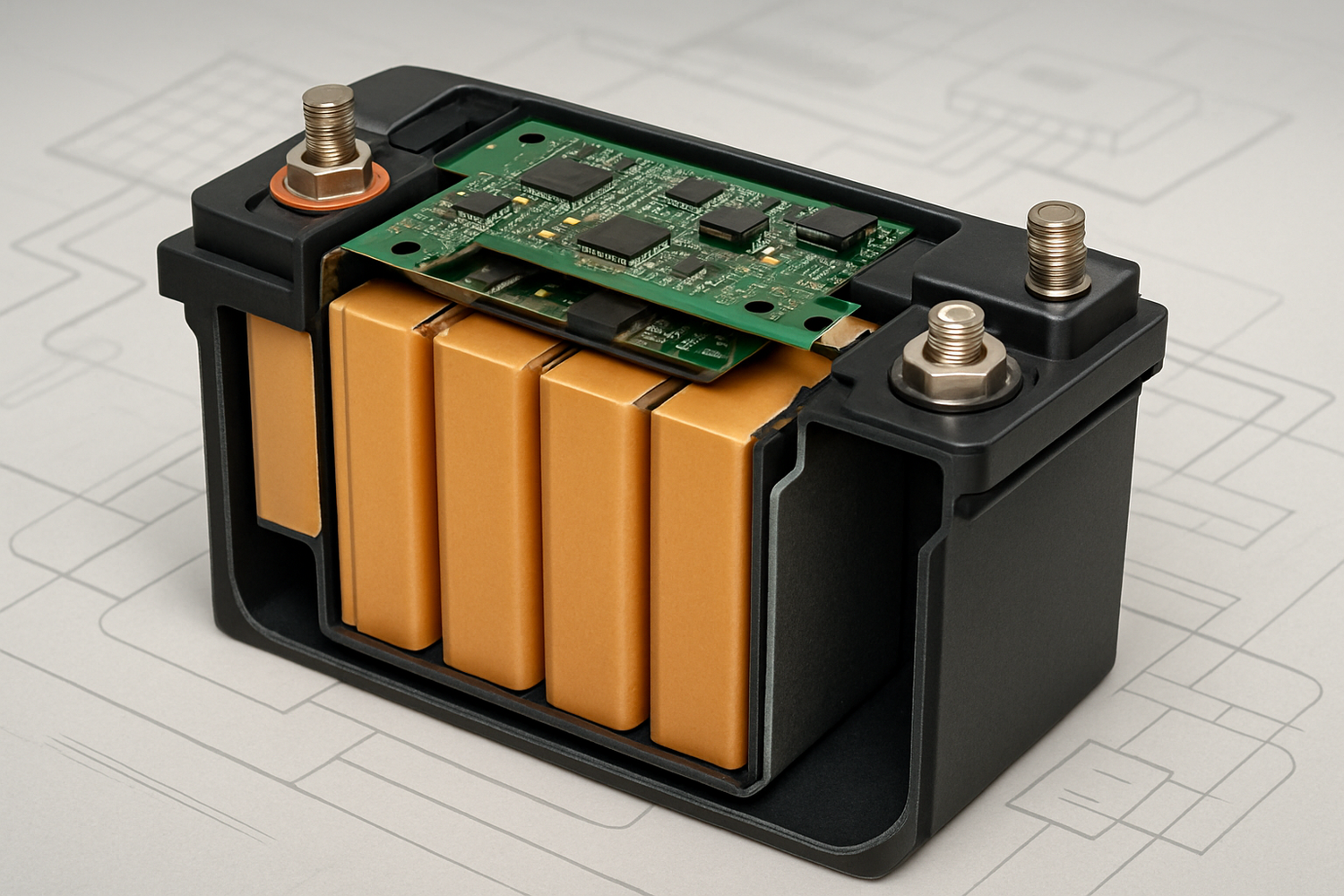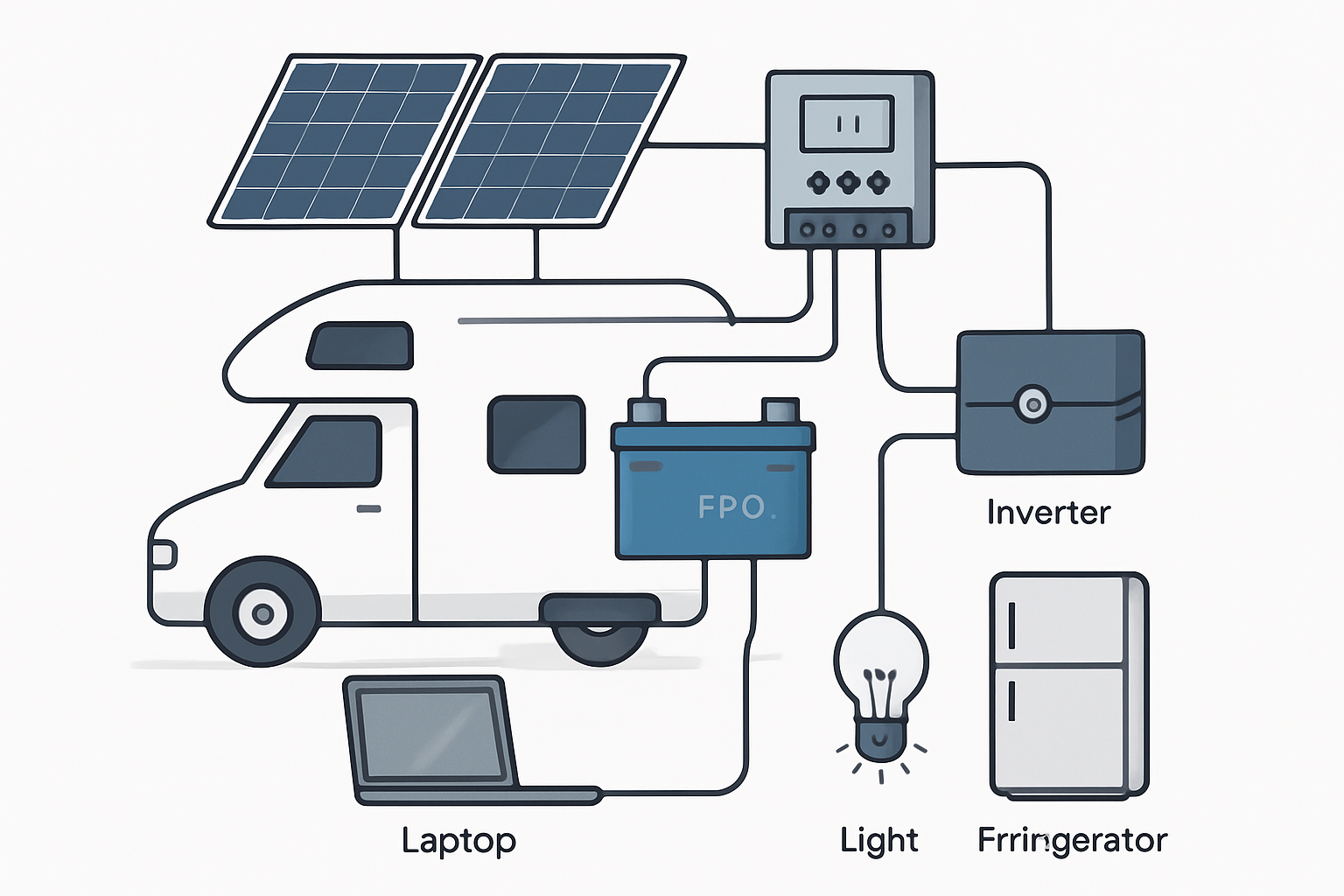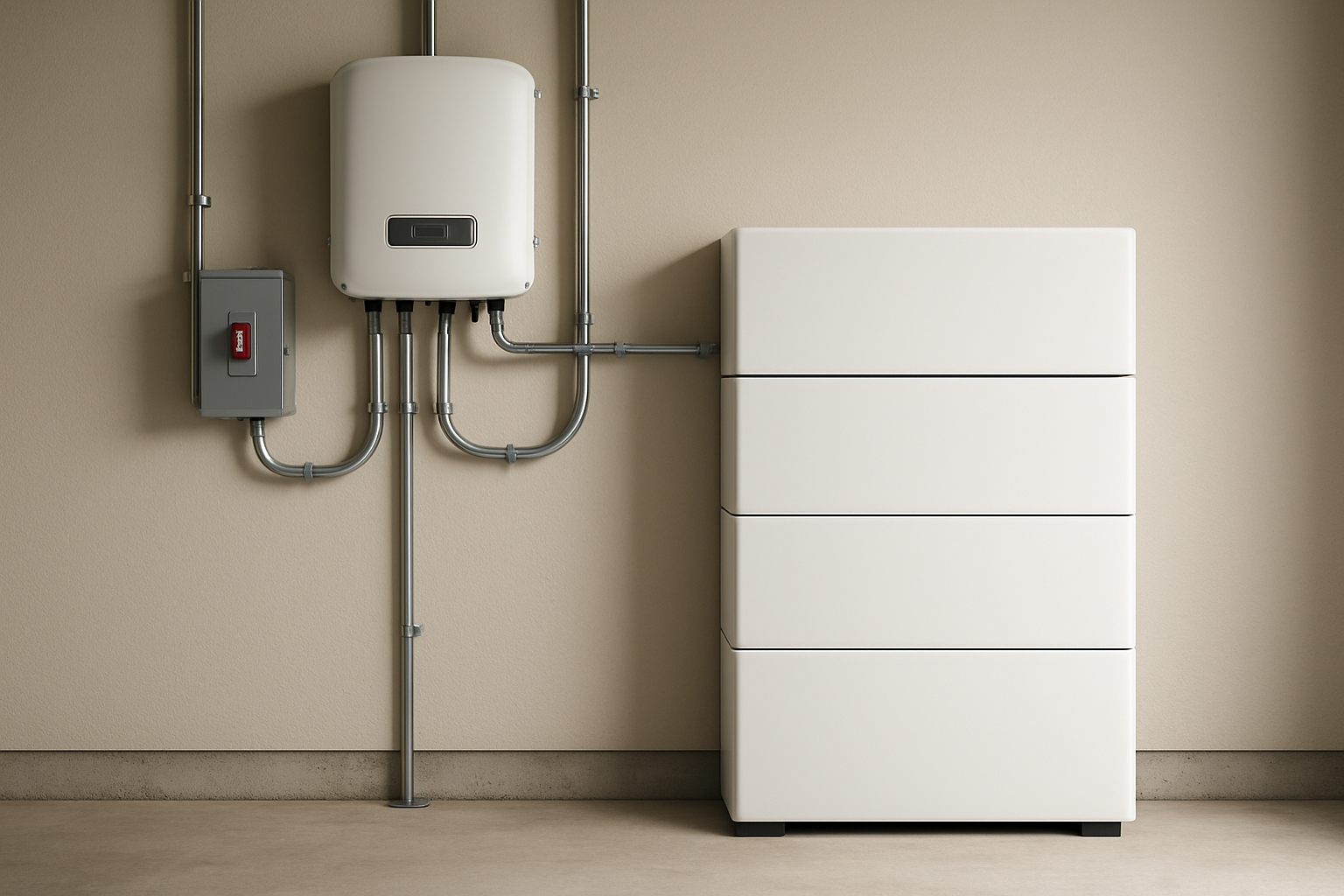The allure of the open road is the freedom it represents—the ability to explore remote landscapes, far from the hum of city life and crowded campgrounds. But true independence requires a reliable source of power. Generators are noisy and dependent on fuel, while shore power keeps you tethered to specific locations. Solar power for recreational vehicles offers a quiet, clean, and sustainable solution, transforming your RV into a self-sufficient haven for off-grid adventures.
This guide provides a comprehensive look at RV solar charging. We will cover the essential components, show you how to design a system tailored to your needs, and explain why modern battery technology is central to a successful setup. My years of experience in the solar and energy storage industry have taught me that a well-planned system is the key to unlocking true energy independence.
The Four Pillars of Your RV's Solar Power Setup
An effective RV solar system is more than just panels on the roof. It’s an integrated setup where each component plays a critical role. Understanding these parts is the first step toward building a reliable off-grid energy solution.
Solar Panels: Capturing the Sun's Energy
Solar panels are the foundation of your system, responsible for converting sunlight into DC electricity. For RVs, you'll typically choose between monocrystalline and polycrystalline panels. Monocrystalline panels are generally more efficient, meaning they produce more power in a smaller footprint—a significant advantage on a limited RV roof. Panels also come in rigid and flexible forms. While flexible panels are lightweight, rigid panels offer greater durability and often a longer lifespan, making them a common choice for permanent installations.
The Charge Controller: The Brains of the Operation
A charge controller sits between your solar panels and your battery bank. Its primary job is to regulate the voltage and current coming from the panels to prevent overcharging your batteries, which can cause permanent damage. There are two main types: PWM (Pulse Width Modulation) and MPPT (Maximum Power Point Tracking). MPPT controllers are more advanced and can be up to 30% more efficient at harvesting energy, especially in cooler weather or when battery voltage is low. This efficiency boost makes them the preferred choice for most RV solar charging systems. The U.S. Department of Energy's Solar Energy Technologies Office (SETO) supports innovations that improve solar cost-effectiveness and efficiency, principles that are embodied in technologies like MPPT controllers.
The Battery Bank: Storing Your Power
Your battery bank is the heart of your system, storing the energy collected by your panels for use at night or on cloudy days. Deep-cycle batteries are designed for this purpose, built to withstand repeated charging and discharging. For years, AGM (Absorbent Glass Mat) batteries were the standard. Today, Lithium Iron Phosphate (LiFePO4) batteries have become the superior choice for RVs. They are significantly lighter, have a much longer lifespan, and can be discharged more deeply without damage. Our focus on high-performance, safe LiFePO4 batteries stems from their proven reliability in demanding mobile applications. For a deeper comparison, see our article: LiFePO4 vs. AGM: Which Deep Cycle Lithium Battery Is Best?
The Inverter: Converting Power for Your Appliances
The power stored in your batteries is 12V DC, but many of your household appliances—like microwaves, laptops, and coffee makers—run on 120V AC power. An inverter converts DC power to AC power. It's crucial to choose a Pure Sine Wave inverter, which produces clean, stable electricity safe for sensitive electronics. Modified Sine Wave inverters are cheaper but can damage certain devices. Our line of solar inverters is designed to provide reliable, pure sine wave power for all your off-grid needs.
Designing a System That Meets Your Needs
Sizing your RV solar system correctly is the most critical part of the process. An undersized system will leave you without power when you need it most, while an oversized system is an unnecessary expense. The process involves a careful audit of your energy usage.
Step 1: Calculating Your Daily Energy Consumption
Before you can build, you must measure. Start by listing every electrical device you plan to use and estimate how many hours per day you'll use it. Multiply the device's wattage by its hours of use to find its daily watt-hours (Wh). Sum these up for all devices to get your total daily energy requirement. Being thorough here is essential; underestimating your needs is one of the most common errors. Learn how to avoid this and other issues in 7 Costly Mistakes in RV Solar Energy Storage System Setups.
Example Energy Audit
| Appliance | Power (Watts) | Hours of Use/Day | Daily Watt-Hours (Wh) |
|---|---|---|---|
| LED Lights (x4) | 24W | 4 | 96 Wh |
| Refrigerator | 60W (runs 1/3 of the time) | 8 | 480 Wh |
| Laptop Charging | 65W | 3 | 195 Wh |
| Water Pump | 50W | 0.5 | 25 Wh |
| Total | 796 Wh |
Step 2: Sizing Your Battery Bank
Once you know your daily watt-hours, you can size your battery bank. A key difference between battery chemistries is their usable capacity, or Depth of Discharge (DoD). AGM batteries should only be discharged to 50% to preserve their lifespan, while LiFePO4 batteries can be safely discharged to 80-90% or more. This means a 100Ah LiFePO4 battery provides nearly double the usable energy of a 100Ah AGM battery. To calculate your required battery capacity in amp-hours (Ah), use this formula:
(Total Daily Watt-Hours / Battery Voltage) / Usable DoD = Required Amp-Hours
For our example (796 Wh) with a 12V LiFePO4 battery (90% DoD): (796 Wh / 12V) / 0.90 = 74 Ah. A 100Ah lithium battery would be a great fit. For more on this, check out How to Correctly Size a 100ah Lithium Battery for Your RV and Is a 200ah Lithium Battery Worth the Investment for Your Rig?
Step 3: Determining Your Solar Array Size
Finally, you need enough solar panels to replenish the energy you use each day. The effectiveness of your panels depends on "peak sun hours"—the average number of hours per day when sunlight is intense enough for significant power generation. This number varies by location and season, but a conservative estimate for North America is 4-5 hours. The International Energy Agency (IEA) projects that solar PV will account for about 80% of the global increase in renewable power capacity over the next five years, driven by its versatility and falling costs. This global trend is mirrored in the growing adoption of off-grid RV energy solutions.
Daily Watt-Hours / Peak Sun Hours = Required Solar Wattage
For our example: 796 Wh / 4 hours = 199 Watts. A 200W solar array would meet this need, but it’s wise to oversize by 20-25% to account for cloudy days and system inefficiencies. Therefore, a 250-300W array would be a more resilient choice.
Why LiFePO4 Batteries Are the Standard for Modern RVs
The battery is the cornerstone of an off-grid system. While AGM batteries are a functional technology, LiFePO4 has emerged as the superior choice for nearly every aspect of RV and marine solar systems.
Superior Performance and Lifespan
A LiFePO4 battery can last for 3,000 to 5,000 charge cycles or more, whereas a typical AGM battery might last for 300-700 cycles. This means a lithium battery can last a decade or longer, often outliving the RV itself. They also charge faster and more efficiently and maintain a stable voltage output, ensuring your appliances run smoothly without dimming or faltering as the battery drains. This level of performance is why top manufacturers recommend this technology. Discover more at Why Top Lithium Battery Manufacturers Recommend LiFePO4 Tech.
Safety and Reliability
LiFePO4 chemistry is inherently stable and far less prone to thermal runaway than other lithium-ion chemistries. High-quality LiFePO4 batteries, like those we specialize in, include an integrated Battery Management System (BMS). The BMS is a crucial safety feature that protects the battery from overcharging, over-discharging, extreme temperatures, and short circuits, ensuring safe and reliable operation for years to come.
Long-Term Value Proposition
While the upfront cost of LiFePO4 is higher than AGM, the total cost of ownership is significantly lower. Because they last so much longer, you avoid the cost and hassle of replacing your batteries every few years. Their higher efficiency and usable capacity also mean you may need fewer batteries to achieve your energy goals, saving both weight and space.
10-Year Cost Comparison: LiFePO4 vs. AGM
| Metric | 100Ah LiFePO4 | 100Ah AGM |
|---|---|---|
| Initial Cost (Est.) | $450 | $200 |
| Cycle Life | ~4000 cycles | ~500 cycles |
| Usable Capacity | ~90 Ah | ~50 Ah |
| Replacements in 10 Years | 0 | ~3-4 |
| Total Cost Over 10 Years | $450 | $800 - $1000 |
This long-term value makes LiFePO4 a clear investment in energy independence. For a complete overview, read our RV Solar Charging: The Ultimate 12V LiFePO4 Battery Guide.
Setting Up Your System for Success and Longevity
Proper installation and routine maintenance are key to maximizing the performance and lifespan of your RV solar charging system. While many aspects of an installation are DIY-friendly, working with electricity carries inherent risks.
Key Installation Considerations
When installing your system, pay close attention to wiring and safety components. Use the correct gauge of wire for each connection to minimize voltage drop and prevent overheating. Every positive line connected to the battery bank should have a fuse or circuit breaker appropriately sized for the wire and the load. When mounting panels, ensure they are securely fastened and sealed to prevent water leaks. The International Renewable Energy Agency (IRENA) emphasizes that pairing the electrification of transport with renewable electricity is a critical step in the global energy transition, a principle that applies directly to creating efficient and reliable marine and RV solar systems.
System Monitoring and Maintenance
Once installed, a battery monitor is an invaluable tool. It provides a real-time "fuel gauge" for your battery bank, showing the state of charge, voltage, and current flow. This information helps you manage your energy use effectively. Maintenance is minimal but important: keep your solar panels clean from dust and debris to ensure maximum sunlight absorption, and periodically check that all electrical connections are tight and free of corrosion. For tips on getting the most from your setup, see Stop Wasting Solar: Optimizing Your RV's Lithium Battery Storage.
Disclaimer: The information provided here is for educational purposes only. Electrical work can be dangerous. We strongly recommend consulting with a qualified professional for system installation. This content does not constitute financial or legal advice.
Embracing Off-Grid Freedom with Confidence
A well-designed solar charging system transforms the RV experience. It grants you the freedom to travel wherever you want, whenever you want, without being dependent on external power sources. It’s a quiet, reliable, and sustainable way to power your adventures.
At the core of this freedom is a robust energy storage solution. By pairing high-efficiency solar panels with a durable, high-performance LiFePO4 battery bank, you create a system that you can depend on for years. Our commitment is to provide reliable and scalable energy solutions that empower our customers to achieve true energy independence. With the right knowledge and components, you can confidently explore the world, powered by the sun. Ready to take the next step? See how you can Unlock Off-Grid Freedom with a 12V 100Ah Lithium Battery.





Leave a comment
All comments are moderated before being published.
This site is protected by hCaptcha and the hCaptcha Privacy Policy and Terms of Service apply.